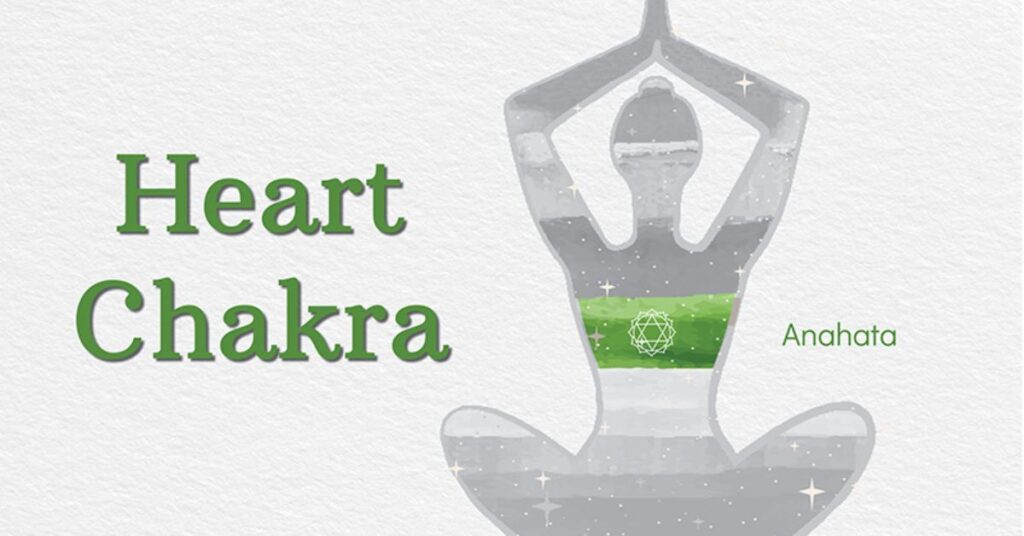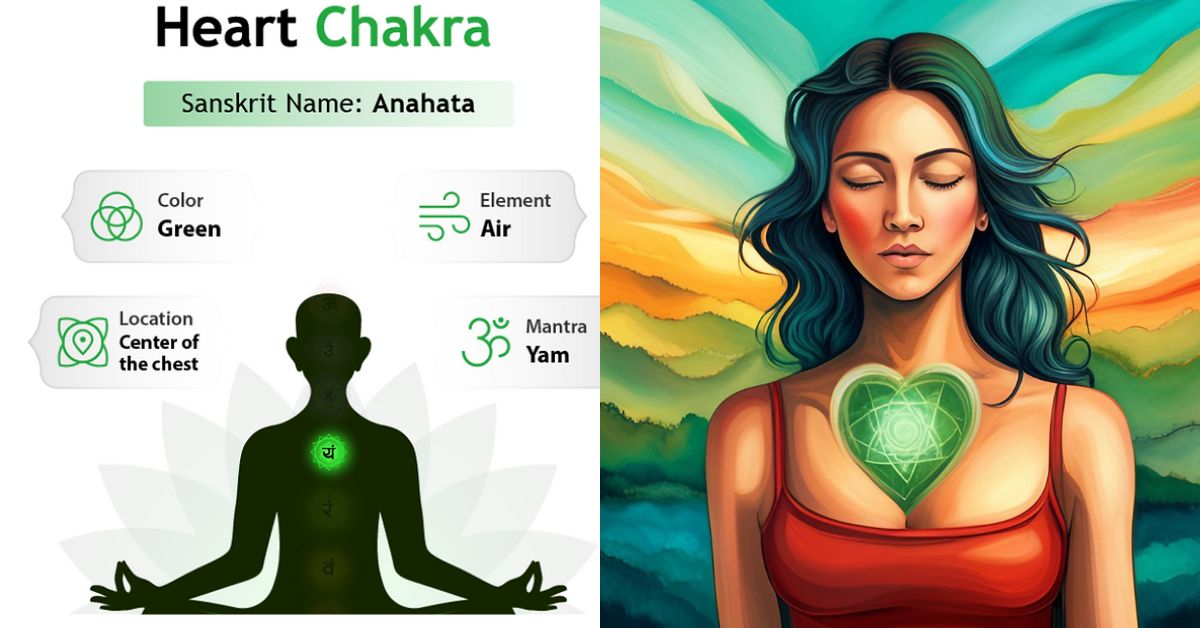The Heart Chakra, also known as Anahata Chakra, is a vital energy center in the body that governs love, compassion, and emotional balance. Understanding this chakra and learning how to keep it in balance is essential for both physical and spiritual well-being. This comprehensive guide will explore what the heart chakra is, how to recognize when it’s blocked or overactive, and how to use yoga and other techniques to maintain its balance.
About the Chakras
Chakras are energy centers in the body that play a crucial role in maintaining our overall health. The term chakra comes from Sanskrit, meaning “wheel,” which symbolizes the spinning vortexes of energy that align along the spine. Originating from ancient Hindu texts, known as the Vedas, these energy centers are integral to Ayurvedic medicine and various forms of yoga and meditation.
There are seven primary chakras, each associated with different aspects of our physical, mental, social, and spiritual well-being:
- Root Chakra (Muladhara): Grounding, survival, and security.
- Sacral Chakra (Svadhisthana): Creativity, sexuality, and emotional expression.
- Solar Plexus Chakra (Manipura): Personal power, self-confidence, and decision-making.
- Heart Chakra (Anahata): Love, compassion, and connection to others.
- Throat Chakra (Vishuddha): Communication and self-expression.
- Third Eye Chakra (Ajna): Intuition, perception, and insight.
- Crown Chakra (Sahasrara): Spiritual connection, enlightenment, and awareness.
A healing energy called prana flows through these chakras, and maintaining a balanced flow is essential for overall wellness. Blocked or overactive chakras can lead to physical, emotional, and spiritual issues, making it important to recognize and address imbalances.
What is the Heart Chakra? (Anahata Chakra)
The Heart Chakra, or Anahata Chakra, is the fourth chakra and serves as a bridge between the lower, more physical chakras and the higher, more spiritual ones. It connects the body to the mind, allowing physical sensations to translate into emotions and spirituality.
Located in the center of the chest, the heart chakra is not only associated with love and compassion, but it also plays a vital role in our ability to connect with others on a deeper level. When this chakra is balanced, it enables us to forgive, to show self-love and self-compassion, and to experience joy and inner peace.
Where is the Heart Chakra?

The heart chakra is aligned along the spine, situated in the middle of the chest, close to the heart center. It corresponds with the heart, lungs, thymus gland, and the cardiac plexus nerves. These physical associations highlight the connection between the heart chakra and our overall health, as it governs the circulatory and respiratory systems.
Heart Chakra and its Physical Associations
| Body Part | Association |
| Heart | Love and emotional balance |
| Lungs | Breath and life force (prana) |
| Thymus gland | Immune system and emotional health |
| Cardiac plexus nerves | Regulation of the heart’s function |
Understanding the physical location and associations of the heart chakra helps us to recognize how imbalances in this energy center can manifest as physical ailments.
Related Blog” 30 Powerful Examples of Transcendental Meditation Mantras
What is the Heart Chakra Associated With?
The heart chakra is associated with a variety of physical, emotional, and spiritual aspects:
- Ability to love and be loved
- Compassion for others
- Empathy and understanding
- Forgiveness
- Self-love and self-compassion
- Joy and inner peace
Additionally, the heart chakra is linked to specific colors, elements, and symbols:
- Color: Green
- Element: Air
- Symbols: Six-pointed star and 12-petaled lotus flower
- Minerals: Jade and Rose quartz
These associations reflect the heart chakra’s role in fostering positive energy, love, and emotional balance.
The Heart Chakra is the Love Chakra
Often referred to as the Love Chakra, the heart chakra is central to our emotional well-being. When prana flows freely through this chakra, we experience inner peace, radiate compassion, and are capable of both giving and receiving love.
Key Qualities of a Balanced Heart Chakra
- Empathy: A deep understanding of others’ feelings.
- Compassion: A strong sense of care and kindness toward others.
- Forgiveness: The ability to forgive oneself and others.
- Self-love: A positive relationship with oneself.
- Connection: A sense of connection with others and the world.
Maintaining these qualities ensures that the heart chakra remains open and balanced, promoting healthy relationships and a positive outlook on life.
Signs of a Blocked Heart Chakra
A blocked heart chakra can significantly impact your physical, emotional, and spiritual health. When the energy in this chakra is obstructed, it manifests in various negative symptoms:
Physical Symptoms
- High blood pressure
- Lowered immunity and more frequent infections
- Heart palpitations
- Poor circulation
- Respiratory conditions
Emotional and Spiritual Symptoms
- Self-loathing
- Anger and bitterness
- Loneliness and depression
- Selfishness
- Refusal to forgive others or oneself
- Inability to open up and connect with others
- Inability to trust people and fear of relationships
- Fear of betrayal
- Unkindness to others and inability to empathize
These symptoms indicate that the heart chakra is blocked and requires attention to restore balance.
Signs of an Overactive Heart Chakra
Conversely, an overactive heart chakra can be just as problematic. When this chakra is too open, it can lead to emotional and behavioral issues that stem from an excess of energy:
Symptoms of an Overactive Heart Chakra
- Overdependence on others, leading to co-dependency
- Needy and jealous behavior in relationships
- Possessiveness and poor boundaries
- Allowing others to take advantage of your kindness
- Giving too much of yourself, leading to emotional exhaustion
An overactive heart chakra can create imbalances in relationships, making it important to recognize and address these symptoms.
Also Related Blog” AA Daily Reflections Meditation: Complete Guide
Yoga Poses to Open the Heart Chakra
Yoga is a powerful tool for opening and balancing the heart chakra. Specific chest-opening yoga poses help to restore the flow of energy, promoting both physical and emotional well-being.
Effective Yoga Poses for the Heart Chakra
- Sphinx Pose:
- Description: Start by lying on your stomach, placing your forearms and hands on the mat with elbows under your shoulders. Press into the mat to lift your chest, allowing the heart chakra to open.
- Benefits: This pose gently opens the chest and heart center, encouraging the flow of energy.
- Camel Pose:
- Description: Kneel on the mat with knees and feet hip-width apart. Lean back to stretch and open the chest, either reaching for your feet or resting hands on your hips.
- Benefits: A deeper chest-opening pose, Camel Pose helps to balance the heart chakra and release stored emotions.
- Bridge Pose:
- Description: Lie on your back with knees bent and feet flat on the mat. Lift your hips while pressing into the mat with your arms, moving your chest toward your chin.
- Benefits: This pose opens the chest and stimulates the heart, promoting circulation and energy flow.
- Wheel Pose (Advanced):
- Description: Lie on your back with knees bent, place palms on the mat by your shoulders, and press into the mat to arch your spine and lift your body.
- Benefits: A challenging pose that fully opens the chest and heart, enhancing the energy flow through the heart chakra.
- Bow Pose:
- Description: Lie on your stomach and reach back to grab your feet as you arch your spine.
- Benefits: This pose is a great alternative to the Wheel Pose, offering a similar chest-opening effect with less intensity.

George, an esteemed author with 8 years of experience in meditation, imparts transformative knowledge on meditatefulhub.com. His writings resonate globally, guiding individuals on a profound journey of self-discovery and inner peace.








![How to Cancel Your Brazzers Subscription Complete Guide [2024]](https://meditatefulhub.com/wp-content/uploads/2024/11/How-to-Cancel-Your-Brazzers-Subscription-Complete-Guide-2024-300x157.jpg)


